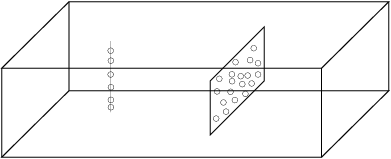Air bubblers have become an integral part of glass-melting tank design. The numerical simulation of bubbling can follow two different paths: a local description of the bubble trajectory or a global description of the action of the bubbles on the momentum equation. Due to the size of the bubbles (which are small compared to the absolute size of a glass furnace), and because of the huge numerical difficulty of adapting the mesh as a function of the bubble location, the model implemented in Ansys Polyflow is based on a global balance introduced in the momentum equation governing the flow.
The Ansys Polyflow bubbling model adds a force term along a line or plane located in the domain of the simulation, consistent with the finite-element formulation of the problem. For 2D simulations, the force always applies along a line. For 3D simulations, you can select either a line model (which uses a vertical line in the flow domain), or a surface model (to have a 2D surface in the 3D flow domain). See Figure 25.2: Bubbling Model with 1D and 2D PMeshes for an illustration.
Lines and surfaces must be identified in the mesh. POLYMESH, PATRAN, and I-deas allow you to import collections of faces (internal or external), which will be identified in Ansys Polydata and on which it will be possible to apply a bubbling model. Defining models on an internal flow region of the flow domain simplifies the domain topology because bubblers do not have to coincide with boundary sets or intersections between internal subdomains. Those 1D and 2D domains internal to an existing mesh are called PMeshes (for "pointer to mesh"). See PMeshes for more information about PMeshes.
Note that, since they are defined at the time of mesh generation, PMeshes always correspond to internal mesh lines or mesh faces.
Domains for bubbling are identified within a particular flow sub-task. Ansys Polyflow scans the mesh to find 1D and 2D PMeshes, and it is possible to define a different model on each of these domains. For a mesh that does not include PMeshes, it is not possible to define a model for bubbling.



